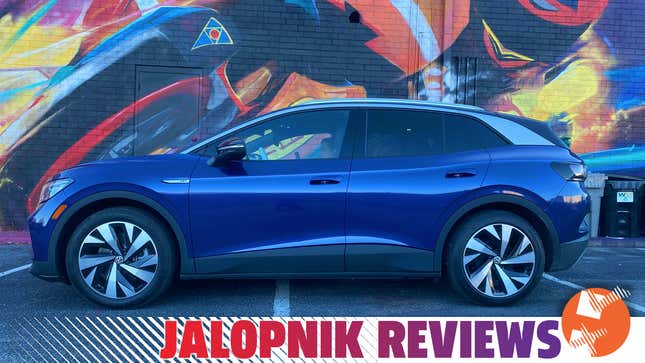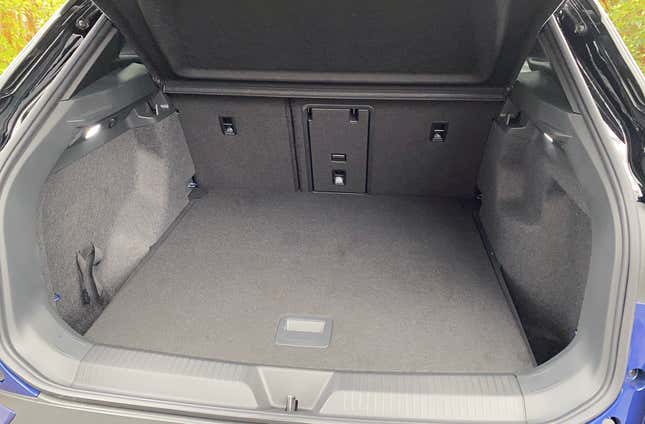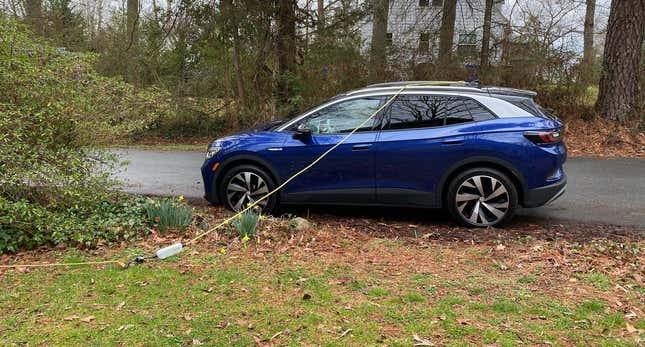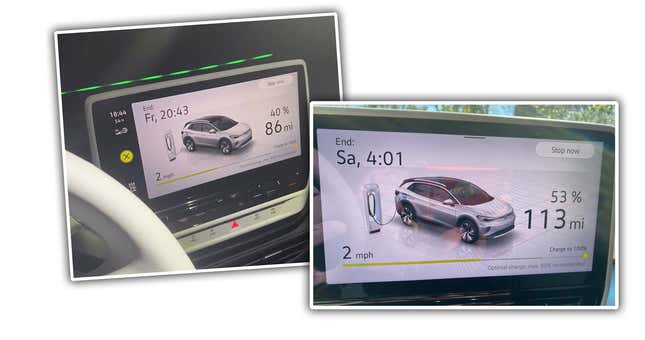
Volkswagen hasn’t exactly been downplaying the importance of its first real mass-market electric car, the ID.4. The company even compared it to the legendary Beetle as far as importance, which I think is a bit hyperbolic. Still, it’s a big deal, and it’s the first taste we Americans will get of the new MEB electric platform. It also marks a glorious return to rear motor/rear drive platforms for VW. The ID.4 is a competent and capable EV — but it’s by no means alone there, and it feels like it could have been more than what it is. And don’t get me started about the lack of a front trunk.
(Full Disclosure: Volkswagen loaned me this ID.4 for about four days, with a battery filled with farm-fresh electrons.)
Maybe one of the most unexpected outcomes of the whole shameful Dieselgate scandal is that it forced VW to really focus on electric cars. It developed an excellent modular EV platform and a showed a whole host of exciting concepts, including a much-awaited Microbus.
The good news here is that the ID.4 has absolutely proven that VW is capable of building good EVs and that the MEB platform is a good platform for them. None of my complaints about the ID.4 have anything to do with that.
From what I could feel and sense and experience, the build quality seems excellent, the ride is very comfortable, the handling good (I mean, I didn’t track it, but for a 4,665-pound brute, it felt quite good), the range decent, acceleration basically fine, all that. Again, Volkswagen has shown they can build a capable EV.
The problem is that now, so can a bunch of other companies, and it’s impossible to evaluate the ID.4 in a vacuum. We have to look at what else is out there, so let’s do that.
How It Fits In
As I see it, this is the pool that VW is jumping into. I wouldn’t normally recommend jumping into a pool with an electric appliance, but I’ll make an exception here:

The VW is the cheapest, which is great, but it’s also the slowest and the only one without extra storage up front. I’ll explain why I’m so stuck on the frunk in a minute. The Ford Mustang Mach-E is only about $3,000 more, though to be really accurate, the model I was given to test is the 1st Edition version, which VW lists at $43,995. I’m not sure we can really say it’s cheaper than the Mach-E, because the one I tested, the one I’m basing this on, isn’t.
Each of these electric SUVs are pretty well-matched size and capability-wise, and each has strengths.
Tesla has, of course, the wildly potent Tesla name and cultural cachet, and is very well-engineered and packaged, but suffers from build quality and service/support issues. Plus, you know, the stans. Still, it’s a good car, and has the best range of the group, which is very important. Plus, it can use Tesla’s excellent network of Superchargers.
The Volvo is the priciest, barely the fastest, and has the smallest range. The interior is great, though, and Volvo usually doesn’t build crap.
The Mach-E is the closest competitor. It’s about the same price, has a bit less range (though, to be fair, I never saw 250 miles of range testing the VW, more on that later), it’s faster, and, if it matters to you, has several chrome horses on it.
And, of course, all these EVs other than the VW have front trunks.
The Big Problem
Okay, so why am I making a big deal out of the front trunk thing? It’s not like the ID.4 is a slouch in the cargo department — the rear hatch opens to plenty of usable room back there. I’m fixated on it because it’s a very clear example of what I think the ID.4's biggest issue is: It doesn’t really feel finished.
Maybe finished isn’t quite the right word. It feels like they didn’t take it far enough, provide enough little extras or evidence of really thoughtful, clever design for the ID.4 to stand out in this group of very closely-matched competitors.
For an example other than the frunklessness, consider this:

See that? That’s the driver’s armrest window controls. On pretty much every car with power windows, the driver has control over every window, via four little switches. Here, though, for some reason there are just two switches and a little touch panel that changes the mode from FRONT to REAR.
I hate it. What if you have a crazy kid in the back seat and you need to quickly roll their window back up because they lowered it to do something stupid?
If you have to select a mode for what windows the buttons act on, it quickly becomes a frustrating mess, and for what? Saving two switches? Or, not even, since they had to add that touch pad there, which is, by the way, impossible to feel and you have to actually take your eyes off the road and look at it and oh it’s just stupid.
The same goes for the laggy touchscreen interface, and the fact that the volume and climate control buttons just below the touchscreen are not illuminated at night, which is just fucking bonkers.

Seriously, look:

It’s great that VW decided to provide physical temperature and volume controls there, even if they are flat, hard-to-feel touch buttons. But then why hide them at night?
Yes, there are volume controls on the steering wheel, okay. But still, would it have killed VW to illuminate those controls? Everything else is illuminated!
See, it’s the little things. And they add up. Especially on EVs, because so much else about EVs are homogenous. These aren’t combustion cars where all kinds of wonderful and irrational preferences come into play. You can love the sound of a particular V8 motor or appreciate the balance of an opposed engine or feel that the car’s engine is placed far enough toward the back to be front-mid or something like that.
Fundamentally, all these competing EVs are skateboards with heavy battery packs in the middle and motors that are cylinders of magnets spinning shafts, pretty silently, connected to a gearbox you never interact with.
When all these cars have such a similar baseline, everything else becomes so much more important: styling, packaging, details like UI interfaces, button illumination, and, yes, trunks.
So the fact that VW is the only one of the bunch that couldn’t be bothered to figure out how to package a trunk up front really means something here, because it suggests an overall lack of attention to detail, and maybe a misreading of just how close the competition is.
The good news is that I think the ID.4 is such a fundamentally good platform that I think these issues can be corrected. VW can put in the extra two switches and update their infotainment UI and, I believe, get a front trunk.
I’ve showed how before, but just to really, really kick the shit out of that dead horse, look at all the crap I was able to put into my ersatz front trunk on the ID.4:

I crammed the charging cable in its bag, the tire inflation kit, the toolkit, a socket set, a squarish soft bag, a briefcase, a camera tripod, and an Atari 2600 in there. And the hood closed just fine. Don’t tell me they couldn’t have packaged a tray in there for a usable trunk because I flapjacking did it.
I hope that VW will consider a little refresh to the ID.4 that takes care of some of these minor but not-insignificant annoyances. Then they’ll find themselves with an absolutely competitive EV.
The Look

Okay, now that I have that off my chest, let’s talk more about the ID.4, starting with the styling. VW intends this to be a very mass-market car, and as such I don’t think they wanted anything too dramatic or polarizing, and they certainly accomplished that.
This thing isn’t going to cause anyone neck injuries as it drives past, but it is handsome, and I think looks as good as any of its competitors.

I like the two-tone effect of the silver roof, and I think the flowing, undulating shoulder and character lines work well. It looks solid without feeling bulky, and even if it’s not screaming at you about how cool and modern it is, you definitely get a sense that it’s both of those things.

I know VW was comparing this to their Beetle, but aside from drivetrain position and layout, it’s really an electric VW Tiguan, in size, design, and purpose. That’s a good call.
As you may remember, I actually own a Tiguan, and it was the general way the car looked and felt that made my wife want it, even though I knew it was a time bomb that did eventually bite me on the ass.
Even so, now that it’s all fixed, she loves it. The idea of a VW with Tiguan style and pleasant interior feel without any timing chain guides whatsoever, anywhere, is a pretty appealing thing.
I mean, I checked — there’s not a single timing chain in this thing.

The lighting design is very nice on the car, too, with illuminated thin light bars front and rear, steerable headlights, and an interesting front side marker lamp design that separates the illuminated portion from the reflector portion, kind of like how U.S.-spec BMW 2002s did.

The badging is in white instead of the traditional chrome, and I like the choice. It’s different but subtle, and acts as one of those subtle design cues to remind people that what they’re looking at isn’t just another combustion-engined car.

VW’s ID series has settled on a family-face design that deals with the loss of a traditional grille well, replacing the usual between-headlights grille area with a black glossy panel with the light bars, and relegating the main air intake below the bumper. Combined with the inward-tapering light design, I think the front end works well.
The Interior

The ID.4 is roomy inside, and the interior materials generally feel good, if not overly opulent.

I like the white steering wheel and instrument binnacle a lot, and I think the little twisty shifter thing on the right side of the instrument pod is intuitive and feels good, though it irked me that it was almost always blocked by the steering wheel, visually, while driving.

The back seat has a nice flat floor and plenty of legroom, or plenty of little-kid-goofball room for nuts like this guy. If you have younger kids that require a car seat, the ISOfix latches in the seat are very easy to access via flip-up plastic covers, which is something I’ve always liked.

Rear seat passengers also get their own air vents and a pair of USB-C ports, which is nice, though the rear seat has no independent HVAC controls.

The rear cargo area is pretty generous. When first opened, you find a nice flat floor and a pair of little cubbies to either rear corner.

That floor, though, is a lie. It’s not the bottom! There’s another sneakily hidden area below it, where you can stash your drugs and Faberge eggs and other things you don’t want anyone’s filthy eyeballs on. You can even remove the hinged upper deck entirely, for hauling bigger things:

And below that lower floor there’s even a basement level, where the charge cables and tire inflation kit and other whatevers hang out:

This, of course, means that to get to your charging cables you’ll need to remove whatever cargo you may have back there, which is a pain, and could be solved if VW just put a trunk up — well, never mind.
With all the seats folded, you should have no problem hauling all kinds of stuff in there — with the upper floor in place, the loading deck stays pretty flat:

It’s also worth noting that the large panoramic roof makes the interior very airy and open-feeling. There’s a powered shade actuated by a little touch panel behind the rear-view mirror that lets you open and close it.

Oh, and it’s a little thing, but I do like the play/pause pedals they put in here.

It’s a bit silly, but in a way that I think helps. I was glad to see it.
Range and Charging

When the car was dropped off to me, the charge level was at 100 percent, and the range was given at 204 miles. The most I saw on the range indicator, after topping it off with my crappy 110 volts of charging was about 211 miles. I never saw it approach 250 on a full charge, though that’s what the current EPA estimate is, and I have seen references to around that amount on other sites.
I took a trip of half back road, half highway travel of about an hour or so each way. My highways speeds were about 75 to 80 MPH, and added some driving in between the trips there and back. I went from around 200 miles when I left, to returning with 86 miles remaining. The car listed that as 40 percent of battery charge, which would suggest that it was calculating a full range of 215 miles on my typical kind of driving.

As far as recharging goes, it’s telling that I didn’t encounter one fast charger in my entire time with the car. I’m sure I could have gone out of my way to find one, but it would have required a special trip.
It’s also significant to note that this has so far been the only press car I’ve gotten from the Charlotte, NC fleet that was trailered to my house. I’m saying all of this as a reminder that the EV charging infrastructure still has a long way to go.
I imagine most people buying these would have 220V fast chargers at their homes, which would let them charge the ID.4 from near-empty to 80 percent in about seven hours or so.
As I do not have such a charger, I tried using the regular old 110V charging, which was easy since I have an extension cord already out, charging up my personal EV, the Changli.

The VW is more finicky than the Changli. I found that the outlet I was using wasn’t properly grounded, which the VW wisely demands.
As is news to nobody, 110V charging is painfully slow.

Over about 14 hours, the trickle of electrons from my wall outlet added 13 percent of charge, going from 86 miles to 113 miles, for a total of 27 miles. That’s usable, I suppose, but if you owned one of these, a 110V charger would not be a viable solution.
So, the takeaway here is I did not see 250 miles of range out of the 77kWh battery pack stuck between the axles. My experience was that 215 or so miles seems a more accurate number for my tests, but, as we all know, battery ranges are wildly variable due to many, many factors, and I didn’t attempt to hypermile or squeeze every last joule out of the pack, either.
Electronic Gizmos And Doohickies

The ID.4 has pretty much the full set of electronics that you’d expect on a modern EV, and that includes puddle lights that make a fun image on the ground, which you can see up there. I think that’s a some kind of interdimensional vortex or something. I accidentally dropped some change into the middle of it, and there was a flash of bluish light and boom, I was 41 cents poorer, so, you know, use caution.
Those puddle lights are just one part of the fun VW was having with the lighting on this thing. A surprising amount of control over ambient lighting is possible, with LEDs in strips along the dash and hidden behind the armrests, allowing for nice, fiery-looking results like this:

It’s fun and all, but, you know, not life-changing. VW did do something a bit more interesting with the LED strip above the dash, which functions as a sort of multipurpose communication tool.

When charging, it pulses and shows you the state of charge, and it performs other functions, like indicating the direction of an upcoming turn when you’re using the navigation system. It’s clever, though if you didn’t know to look for it, I’m not sure you’d realize the things it’s doing.
The ID.4 has a pretty robust suite of driving assists like lane keeping and dynamic cruise control and emergency braking and traffic/speed limit sign recognition that push it very close to that Level 2 semi-automation level, though not quite to the degree of a Tesla Autopilot or GM SuperCruise.

The basic center-stack touchscreen UI is, I think, pretty well designed, and borrows heavily from the phones and tablets that we all use pretty constantly, so none of it is hard to figure out.

The UI design is clean and attractive, and even if you don’t like it, you can always use Apple CarPlay or Android Auto for most of your needs.
My problem with it was the performance. The system felt a bit laggy, like it was running software just a bit too much for the CPU to comfortably handle. Sometimes it was fine, and sometimes it was annoying, but when it comes to car controls, any lagginess is just not something you want to deal with while driving.
There’s voice controls, too, though the most I did with them was to say “Hey ID, tell me a joke,” which you can hear the results of in that video near the top of this review. The speech synthesis quality seemed a bit worse than what you’re likely used to from Siri or Alexa, which makes you wonder why that is?
Was the unit used to control all this stuff maybe selected more for cost than performance? Maybe. That certainly wouldn’t be unusual in the car world, but it does feel a bit more obvious than I think you’d like.

One nice touch was that Apple Maps directions would appear right on the main instrument screen, which is nice, and not something I’m sure I’ve seen in many other cars.
Oh, one more thing — like most new cars, all the ports are USB-Cs, so it’s probably time to get those cables. Luckily, it does have a wireless charging pad if you’re like me and haven’t really bothered to get any new USB-C cables yet. I still have a few DB-25 RS-232 cables, though, if that would help.
Driving It

Even with only 201 HP (and 228 pound-feet of torque) and 4,665 pounds (per VW’s own specifications) to push around, the ID.4 never felt slow to me. I mean, sure, my daily has 52 HP on tap, so it’s possible I’m not your ideal judge, but I had no problems keeping up with traffic, passing, merging, anything. It was fine.
It even felt pretty quick when you stomp on the gas — wait, the electricity — pedal, and 7 point whatever seconds to get to 60 isn’t that slow. I mean, an AMC AMX did 0-60 in about 7.6 seconds, and we all think of that as a muscle car.
From 1973, sure, but still! It’s fine.
I wish I had driven it in a context where I could feel some sort of difference RWD makes, but the truth is I didn’t, and the bigger truth is most people buying these won’t, either.
It drives easily and comfortably. It’s smooth and quick enough and doesn’t take much effort at all. It handles bumps and curves with the confident smoothness that over 1000 pounds of centrally, low-mounted battery can give you. It’s fine. This is what the target audience of these cars want, anyway.
The Verdict

I think, really, I made my take on the ID.4 pretty clear at the start of this review: It’s a well-executed, competent EV that will handle most people’s basic car needs just fine.
That said, it has some stiff competition, and I feel like VW needs to do more with this car to really give buyers a reason to pick it over, say, a Ford Mustang Mach-E, which costs about the same, is about the same size, has a bit less indicated range, but is quicker and, yes, has an extra trunk up front.
What the ID.4 really did for me is drive home that VW has a good electric platform, and made me excited for the more interesting cars that will be built on it, like the ID.Buzz new Microbus.
The ID.4 needs something to set it more apart from the pack. If VW could fix the little annoyances I mentioned, that would help, or if they could manage to sell it for, say, $30,000 or even $35,000, that would make a huge difference.
The ID.4 has potential to be the mass-market EV winner VW is hoping for, but it’s going to take something that shows how much VW really wants this. They need to step up and finish the job they’ve started here.
I think it’s possible to do it, but first VW needs to realize it.
